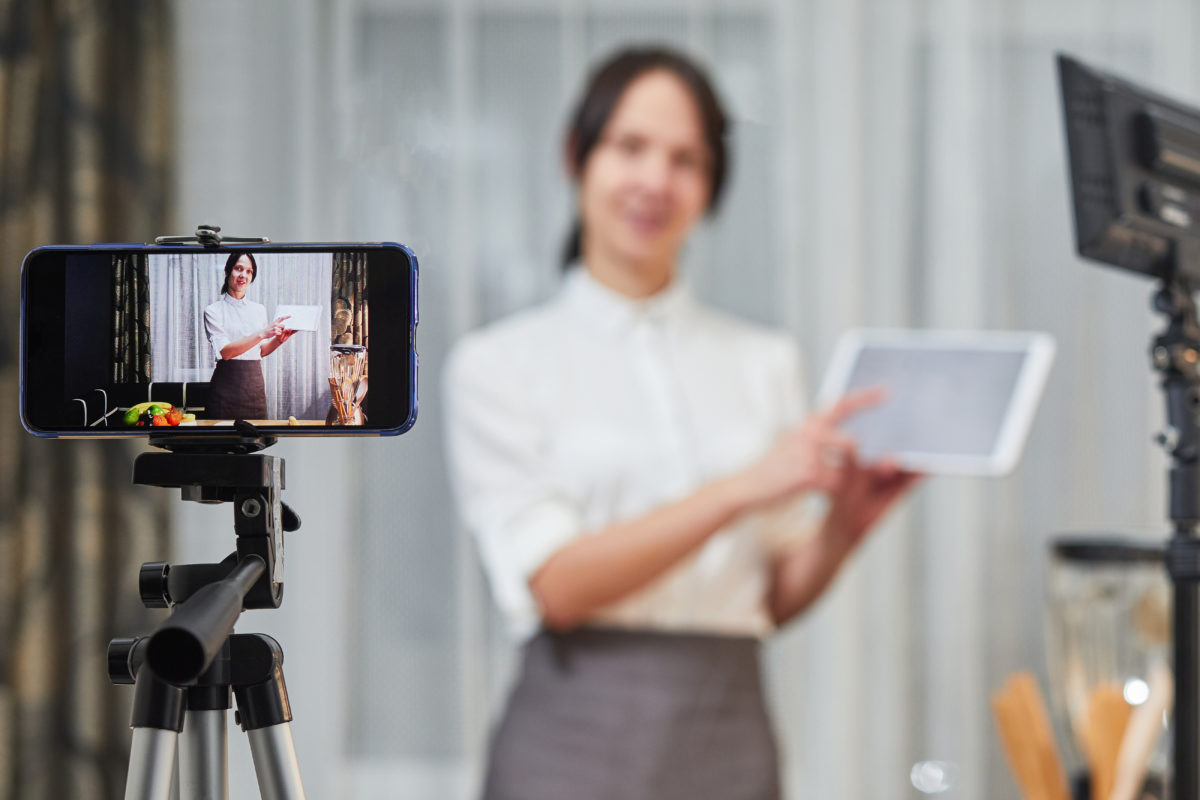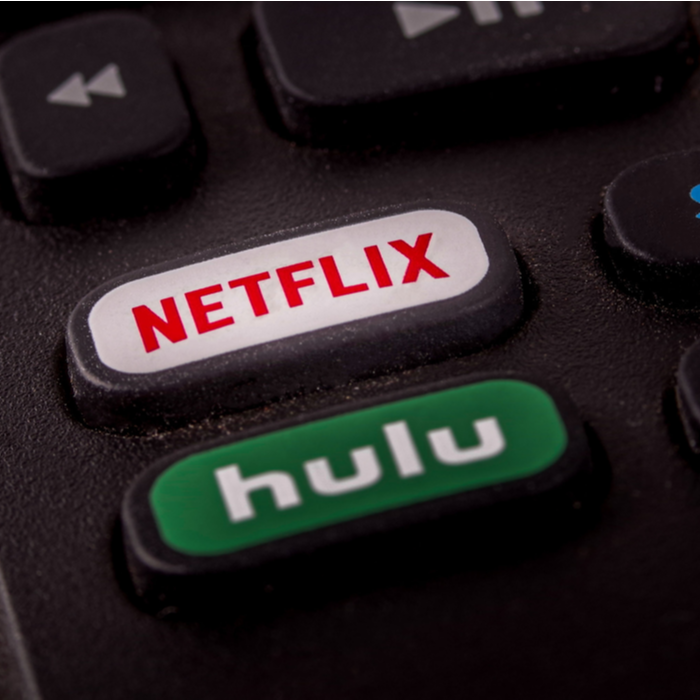
4 Tips for Shooting Video of Yourself on Your Phone
- Setting
-
- Choose a space that is well-lit with as little background noise as possible.
- Avoid spaces where you will be back-lit, such as sitting in front of a window or a lamp, as this could cause you to be silhouetted and difficult to see. Position yourself to keep your main light source in front of you.
- Also, avoid spaces where there would be distracting clutter in the shot.
- Framing your shot
-
- Position the camera at your eye level to avoid shooting yourself at high or low angles, and keep yourself centered in the frame.
- Use a tripod to keep your camera steady. Some selfie sticks come with a built-in tripod. If you don’t have this equipment available, then propping up the phone on a flat surface can work.
- Front or back-facing camera
The back-facing camera on your phone will provide higher quality video due to a better lens and higher megapixels. But if you prefer to be able to see yourself as you shoot, then you can use the front-facing camera.
KEEP IN MIND: As you’re shooting, keep eye contact with the lens as if it’s the person you’re talking to.
- Hitting the record button
-
- Give yourself a couple of seconds after you hit the record button to start talking. This will give the final video editor room to splice in your video and transition between others.
- Be sure to smile before you start talking and after you finish.
- Speak clearly and avoid muttering or trailing off as you talk.
- Some more helpful tips
-
- Keep water on hand (but make sure you can’t see it in the shot) for when your mouth or throat get dry.
- Avoid wearing jewelry that can make noise, like bangled bracelets.
- Don’t be too hard on yourself. Most people get nervous being on camera and it can take multiple tries to get it right!

Advertising Locally on Streaming TV
Advertising Locally on Streaming TV (specifically Hulu)
I think everyone knows what streaming TV is, but in the very basic terms, it is the digital distribution of any video content that is consumed on TV screens. Some popular platforms are Disney+, Netflix, Prime and for this article, Hulu.
I am focusing on Hulu because they are the first service to offer local insertions in their programming. This is huge for local advertisers! According to Nielsen, adults 18-34 traditional TV ratings have declined 69% since 2017. So in 4 short years, 70% of adults under 35 years of age, are no longer watching traditional, local news station content over the air, or through traditional cable service providers. I for one have been a huge fan of “Only Murders in the Building” on Hulu, and when a platform has successful content such as this, it increases usage in large numbers. As an example, I am now watching the Hulu platform almost daily at some point, whereas before the show, I did not.
So why is this important? Because like me, Hulu viewership is up in a big way. As Hulu puts it, we are starting to see GENERATION STREAM come to maturity and they consume their content almost exclusively on a streaming service. In fact, Hulu’s research points that ads on their platforms are 151% more engaging than linear TV. There are many reasons for this, but their limited content breaks and non-traditional approach to breaks in general, makes for a better user experience.
The new Hulu self-service option to buying and inserting ads locally in their programming, for as little as $500, is something I hope local companies will take advantage of!
Guide To World Cup Advertising Success
The World Cup is a great place to raise brand awareness, but probably isn't the event you're going to debut a new product or unveil a revolutionary idea. This is simply because the World Cup has a global viewership and is fragmented based largely upon national allegiances. For instance, viewership in England among women increases from 38% to 46% when their native country is playing (The Guardian, June 2010). Another reason for this is that the event takes place over the course of a month and is similar to March Madness in that regard.
Because many companies see the World Cup as an opportunity to showcase their business on a global scale, the creative is top-notch. This may be one of the reasons that the ads resonate with women more than with men, although the viewership skews more male than female.
In an event that showcases superstars like Messi, Suarez, Neymar, and Ronaldo…this is your opportunity to make your business the hero. YOU'RE the superstar. Now is not the time to do a human interest piece that tugs at your heart strings. Promote the brand early.
Unexpected ads that work within the context of the World Cup seem to gain traction among viewers. The popular ” I believe that we will win” chant that the USA has adopted, might be a good example of how a business might pair nationalism, fanaticism, and product placement if it fits with the brand.
Celebrity endorsements are hit and miss. It would take a global superstar with incredible recognition for this to work they way people are accustomed.
Finally, clarity of vision is paramount.
So, there you have it! Take these tips and corner kick them to your best play-maker for a game-winning header and enjoy the fruits of your labor!
The Epic Battle for Net Neutrality
What is net neutrality? Well, net neutrality is the “principle that Internet service providers should enable access to all content and applications regardless of the source, and without favoring or blocking particular products or websites.” Basically, one website can’t be favored over another in terms of speed or accessibility just because they paid for it.
Typically, when this topic is discussed, proponents of net neutrality mention how consumers will not be given equal access to internet content such as streaming services unless the website or the consumer pays for it. They argue that smaller websites who cannot pay outrageous fees to keep their content accessible will fail. Freedom of internet speech will be given only to large corporations with enough money to pay for it. This is true, but not the only problem. All small businesses, not only those in entertainment, will be hurt if the internet is not kept open and accessible.
Smaller marketing firms, and by extension other small businesses, will be hurt tremendously if net neutrality ceases to exist. Small businesses often rely on the internet as a cost-effective form of advertising. The internet allows small businesses to reach people around the world at a much cheaper rate than traditional media. If net neutrality is abolished, small businesses will no longer be able to compete against large corporations for cheap ad-space on the internet. Large corporations will have the money to advertise on sites that are more accessible to consumers.
In short, this is a very big deal. Just ask Netflix…who had a brief fallout with Comcast…their streaming content was streaming noticeably slower until they reached a compromise with the internet service provider. Lo and behold, in February, they began to see an immediate improvement (or perhaps just restoration of where it once was) in streaming speed. Netflix was literally held hostage by Comcast until its demands were met. It's naive to think they playing field will ever be completely level, but steps should definitely be taken to ensure that we're doing all we can.
Netflix Re-brand and More
The logo has received mixed reviews by various internet blogs. Some people think that the new logo is more modern and shows that Netflix is moving away from being just a movie platform. It represents their move into original content such as House of Cards and Orange is the New Black. Others feel that the new logo is a downgrade from the original that takes away the cinema feel but brings nothing in return.
Netflix’s logo change follows a trend of numerous companies changing their logos or other aspects of their brand identities. Some have received positive reviews while others have lost customers due to the change. One example of an excellent rebrand is Old Spice. They targeted a new demographic with an innovative strategy and saw sales skyrocket. There are also examples of rebranding mishaps such as the ill-received Gap logo redesign which only lasted for one week before the original logo came back.
So this begs the question, when should a company rebrand? There are positive and negative factors to consider when you are making any changes to your company’s brand identity. Is it worth the cost? Is it worth the risk that employees and customers may not accept the change? Will this new change bring in the clientele your business is looking for? Does this change better represent how you want your business to be perceived?
You may want to change your branding if your current brand is boring or stale, if it has a bad reputation, if you are changing services or target audience, or if there is a change in ownership/management. But always remember that any change you make may alienate your current clientele and hurt your business.
A company should always do its research before settling on new branding. That may be what Netflix is doing by only revealing their new logo design on a promotional piece. They may be testing the waters to see how the general public feels about the change. We will just have to wait and see.


